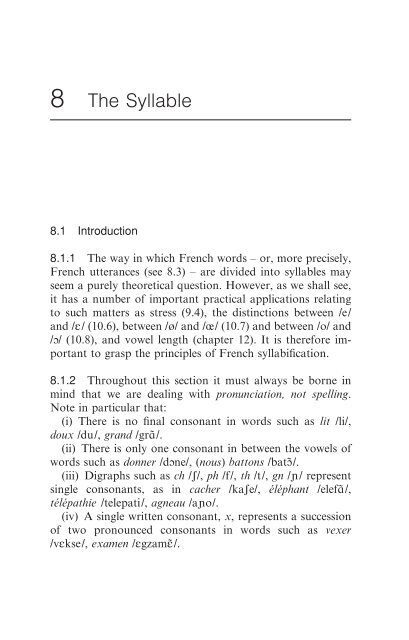An Introduction to French Pronunciation
An Introduction to French Pronunciation
An Introduction to French Pronunciation
You also want an ePaper? Increase the reach of your titles
YUMPU automatically turns print PDFs into web optimized ePapers that Google loves.
8 The Syllable<br />
8.1 <strong>Introduction</strong><br />
The Syllable 41<br />
8.1.1 The way in which <strong>French</strong> words – or, more precisely,<br />
<strong>French</strong> utterances (see 8.3) – are divided in<strong>to</strong> syllables may<br />
seem a purely theoretical question. However, as we shall see,<br />
it has a number of important practical applications relating<br />
<strong>to</strong> such matters as stress (9.4), the distinctions between /e/<br />
and /ε/ (10.6), between /ø/ and /œ/ (10.7) and between /o/ and<br />
/b/ (10.8), and vowel length (chapter 12). It is therefore important<br />
<strong>to</strong> grasp the principles of <strong>French</strong> syllabification.<br />
8.1.2 Throughout this section it must always be borne in<br />
mind that we are dealing with pronunciation, not spelling.<br />
Note in particular that:<br />
(i) There is no final consonant in words such as lit /li/,<br />
doux /du/, grand /gre/.<br />
(ii) There is only one consonant in between the vowels of<br />
words such as donner /dbne/, (nous) bat<strong>to</strong>ns /batf/.<br />
(iii) Digraphs such as ch /ʃ/, ph /f/, th /t/, gn // represent<br />
single consonants, as in cacher /kaʃe/, éléphant /elefe/,<br />
télépathie /telepati/, agneau /ao/.<br />
(iv) A single written consonant, x, represents a succession<br />
of two pronounced consonants in words such as vexer<br />
/vεkse/, examen /εgzamh/.












